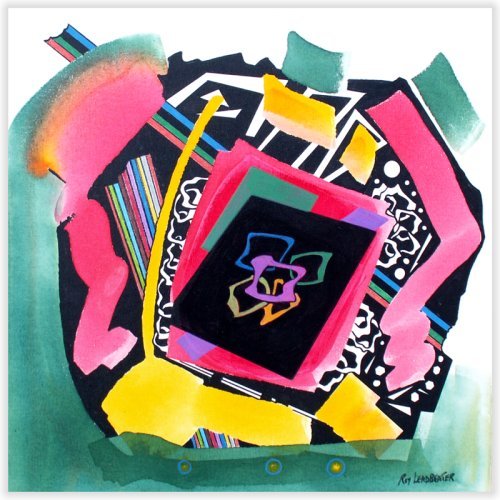 |
| Image credit: Roy Leadbeater, Deep Space Butterfly 24"W x 24"H Acrylic on canvas |
I unexpectedly had tea with Roy Leadbeater this afternoon, and I’ll admit I only knew him by name until now.
His works are around town, the dancing musical fence along 104 St and 102 St, the big blue sculpture outside of the Citadel, the recognizable abstract shapes and primary colours, recognizable but also very different in how we treat steel (especially around these parts).
He’s led quite a life, from being a direct descendant to the famous Wedgewood potters in England to working as a marine engineer to posting as an officer in the Middle East, he’s 82 and still painting every day, and making sculptures on commission.
He said something that needs a bit of unpacking, besides a quick quip that the sky here reminds him of being at sea going nine knots, and that is he doesn’t consider himself a Canadian artist, because he’s too cosmopolitan. Simply put, he’s not interested in landscapes.
His sentiment can be taken as a joke, and it is the ongoing joke about Canadian art that stopped being funny, but I’m pretty sure he was quite serious about defining himself as not a Canadian artist based on this criteria.
The cache of a Canadian artist from an international lens is exoticized still, not always, but because we still don’t know how to define ourselves, Canadian art on the international stage looks like a travel brochure. Intangible wilderness that is pristine, yet controlled, and Aboriginal representation that is acutely subverting the traditonal. The main problem with a travel brochure is not the quality of its contents, but its lack of complexity--and diversity--in suturing contemporary issues with its own mired history.
I can't get a grasp of a "Canadian" aesthetic, as I tend to favour the regional approach, and Leadbeater for all of his international panache fits into this category, with his focus on the mechanics of space, his inspiration from engineering, his time in the oil industry, his preference for materials and methods that is innately industry-driven. They are also done from the perspective of the workers. There are ties to other revolutionary working class styles, early Russian abstract works, hints of Futurism. And by his intimate knowledge of Picasso’s life stories, Cubism and the thoughts behind that, the notion of absurding the representational, the status quo, remain alive in his Alberta-based work.
1 comment:
This is a great piece Amy. Really provoking. If you have the chance it would be interesting to write more about Canadian art and Sophistication. It is something that Zach and I (unknowinly until you provided the words) are dealing with. Is it worth becoming a 'Canadian' artist? Yet how can one avoid it? I am Canadian. Edmonton is my home, even when I move in terms of foundational influences - and yet I want more - in terms of my own production and life in general. Futurism indeed.
Post a Comment